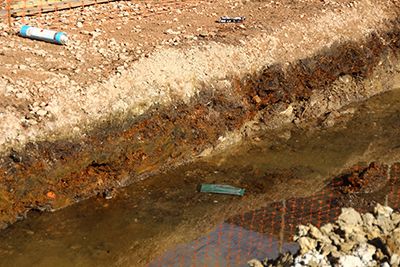X-ray fluorescence (XRF) can detect heavy-metal soil contamination with great accuracy. We recently spoke to Julian Puzyna, a freelance civil engineer that specializes in ground exploration and contaminated land assessments. Over the last 20 years, he has investigated over 700 contaminated sites. He is now exploring the potential for using a portable Vanta™ XRF analyzer in the contamination assessment process.
How did you use the Vanta analyzer for the contaminated soil assessment?
I had the opportunity to try the Vanta portable XRF analyzer on a construction site in Berkshire [UK] where we had encountered lead contamination in an open field. The fields were underlain by clays, and the lead was only found in the overlying topsoils. I suspected that the lead was from the use of shotguns since I had found many buried cartridges in an area used for waste disposal.
The Vanta XRF analyzer was used at 40 locations across the field where the topsoil was opened up and overturned using a spade. The results were consistent with what we had seen previously and confirmed that the center of the contamination was near the end of a ditch that crossed the field.
Three comparison samples were taken, scanned using the XRF analyzer, sealed, and then sent for laboratory analysis. The results show very good accuracy with respect to human health assessments and were within the error values quoted by the analyzer. Laboratory analysis also showed that the moisture content of the soil was around 50%.
| Test Number | Sample | Vanta XRF | Lab DW | Moisture | Lab WW |
| 33 | s1 | 49 | 71 | 50.3 | 47.2 |
| 37 | s2 | 47 | 69 | 56.4 | 44.1 |
| 41 & 42 | s3 average | 77.5 | 118 | 63.6 | 72.12 |
| Values in mg/kg (ppm); DW = dry weight concentration; WW = wet weight concentration | |||||
How is this kind of contaminated land currently analyzed?
In general, most of the analysis is carried out by recovering representative samples for laboratory analysis. The analysis for metals is usually limited to the most toxic of the heavy metals (arsenic (As), cadmium (Cd), chromium (Cr), copper (Cu), mercury (Hg), lead (Pb), nickel (Ni), antimony (Sb), vanadium (V), and zinc (Zn)).
The laboratory analysis is normally based on an aqua regia digest of the sample, which is then analyzed using a mass spectrometer. The time taken to receive results is usually about ten working days. This can be accelerated to one or two days, but at a significant extra cost to jump the queue.
The analysis, of course, hinges on good sampling by an experienced assessor who understands the signs of contamination and also understands the ground and where contaminants are likely to be migrating or accumulating.
How can XRF technology contribute to contaminated land assessment?
In this picture (right), we can see a band of buried metal waste. The band is orange-brown, or rust colored, from the corroded iron and is easy to spot. The question of whether any contaminants from the corroded iron have spread into the underlying layers of soil cannot be determined visually.
In this instance, laboratory analysis revealed very high concentrations of arsenic, barium, cadmium, chromium, copper, lead, and nickel in the rust-brown colored layer. The analysis also showed that the underlying soil contained very low concentrations of these metals. The metal-contaminated layer was later removed.
An XRF analyzer would have shown what was hiding in the corroded metal layer — and would have also shown that the underlying soils were unaffected — on our first site visit. The reality of the situation on this site was that all work was suspended for over two weeks while we waited for the lab results.
XRF devices now open up new possibilities. As discussed above, results can be obtained on-site rather than two weeks later, and this is a huge benefit. The other great benefit will be the number of areas I can test and the ability to directly test the stems and roots of shrubs, tubers exposed by excavation, and even the fruit hanging on the trees.
With this increase in data, the models predicting human uptake can be used more accurately, and the assessment of contaminated ground becomes more and more reliable.
Related Content
- Hidden Danger: Screening Garden Soil for High Levels of Lead
- Handheld XRF Tests Lead (Pb) in Soil, Dust, and On Surfaces
- XRF Technology for Analysis of Arsenic and Lead in Soil
Get In Touch


